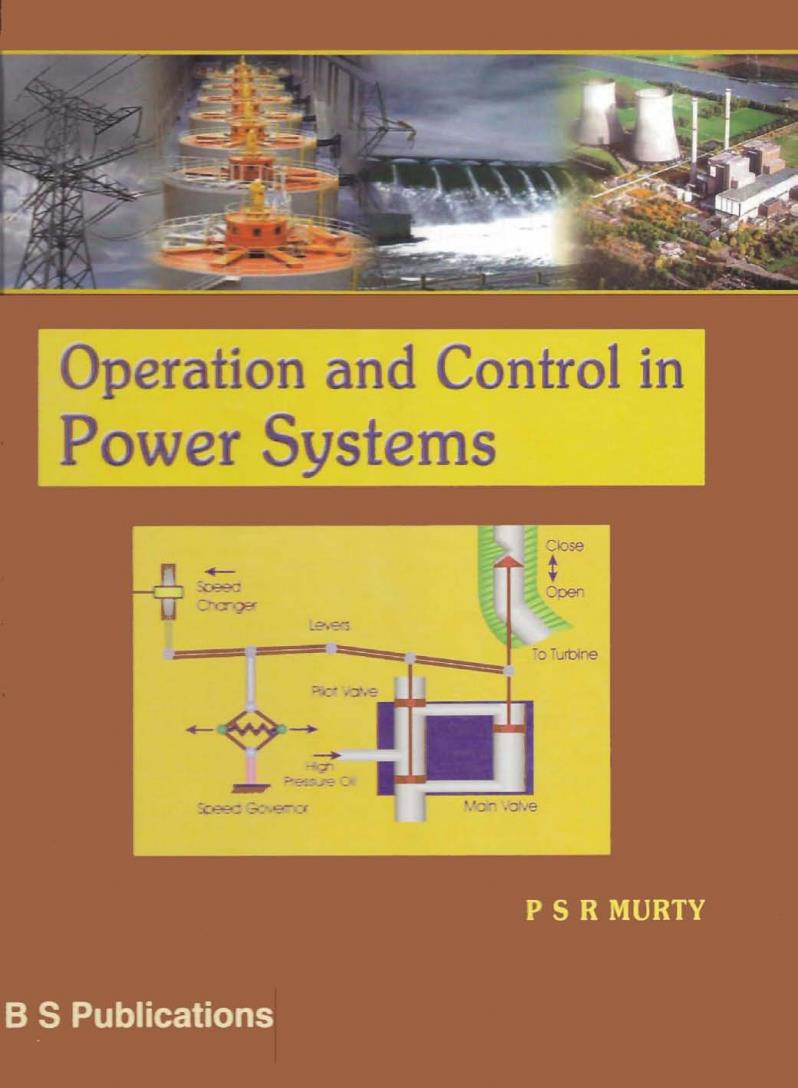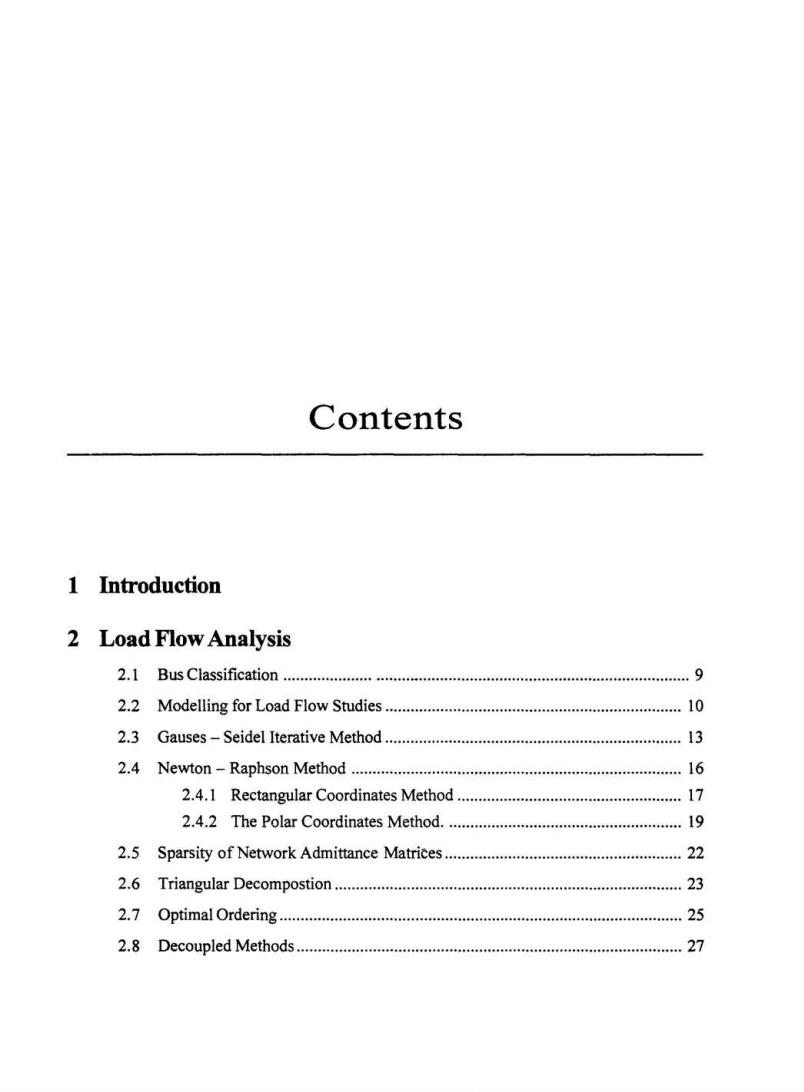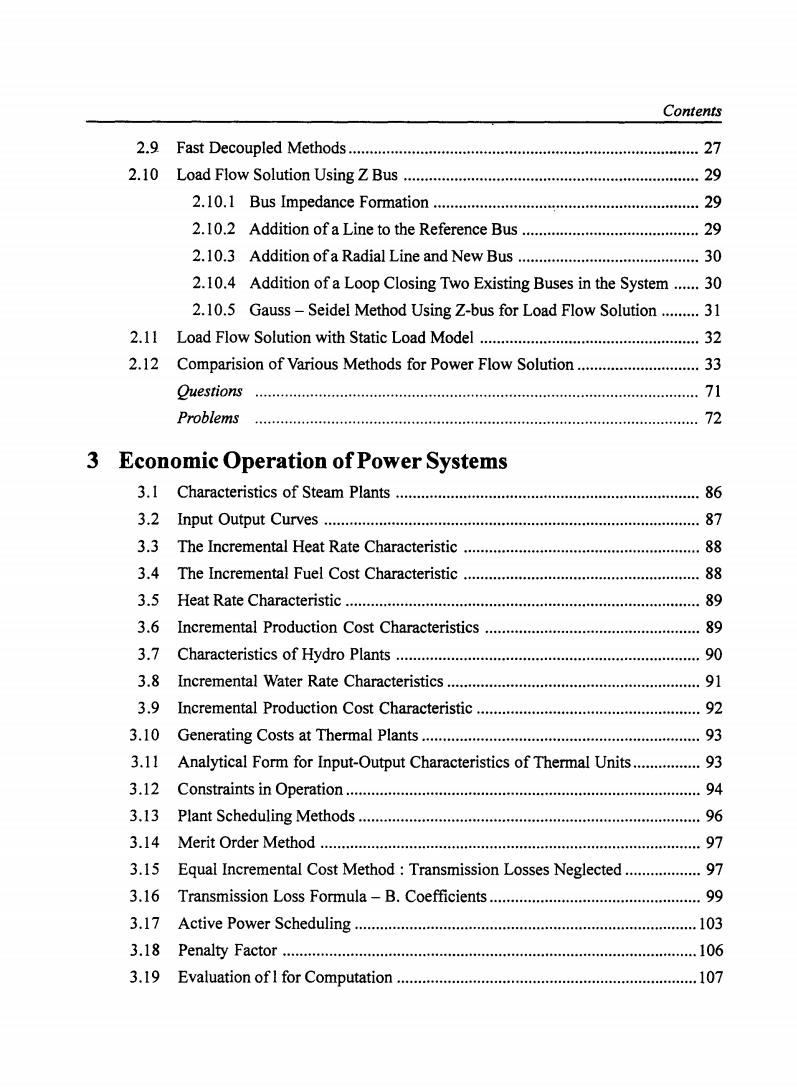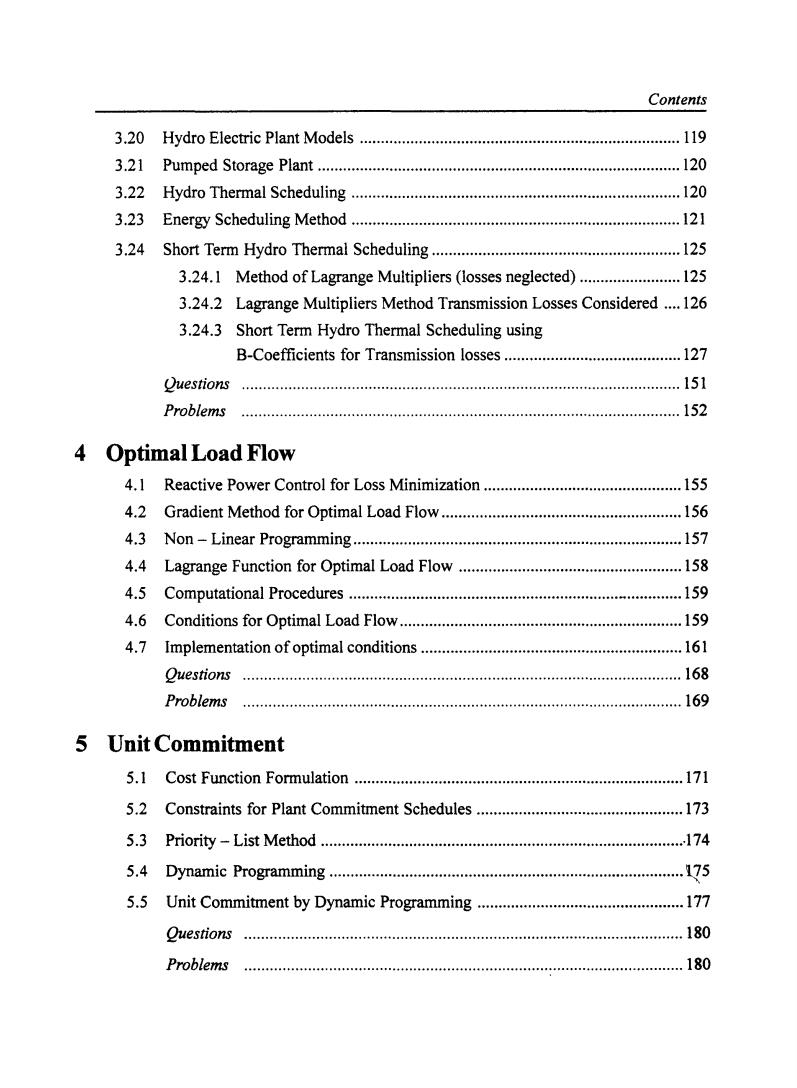
Operation and Control in Power Systems Ciose D02 ⊙,e To Turbine 过 P@ 022C3890 Mon Volve P S R MURTY B S Publications

Contents 1 Introduction 2 Load Flow Analysis 2.2 Modelling for Load Flow Studies. 10 2.3 Gauses-Seidel Iterative Method.... 13 2.4 Newton-Raphson Method ............. 16 2.4.1 Rectangular Coordinates Method....... 17 2.4.2 The Polar Coordinates Method...... 19 2.5 Sparsity of Network Admittance Matrices...... 22 2.6 Triangular Decompostion....... 23 2.7 Optimal Ordering… 25 2.8 Decoupled Methods........ 27
Contents 1 Introduction 2 Load Flow Analysis 2.1 Bus Classification ............................................................................................... 9 2.2 Modelling for Load Flow Studies ...................................................................... 10 2.3 Gauses - Seidel Iterative Method ...................................................................... 13 2.4 Newton - Raphson Method .............................................................................. 16 2.4.1 Rectangular Coordinates Method ..................................................... 17 2.4.2 The Polar Coordinates Method ........................................................ 19 2.5 Sparsity of Network Admittance Matrices ........................................................ 22 2.6 Triangular Decompostion .................................................................................. 23 2.7 Optimal Ordering ............................................................................................... 25 2.8 Decoupled Methods ........................................................................................... 27

Contents 2.9 Fast Decoupled Methods........... 27 2.10 Load Flow Solution Using Z Bus ............... .29 2.10.1 Bus Impedance Formation .............. .29 2.10.2 Addition of a Line to the Reference Bus ...................... …29 2.10.3 Addition ofa Radial Line and New Bus ...........................30 2.10.4 Addition of a Loop Closing Two Existing Buses in the System......30 2.10.5 Gauss-Seidel Method Using Z-bus for Load Flow Solution.........31 2.11 Load Flow Solution with Static Load Model............32 2.12 Comparision of Various Methods for Power Flow Solution.....33 Problems 72 3 Economic Operation of Power Systems 3.1 Characteristics of Steam Plants ............ 86 3.2 Input Output Curves.... .87 3.3 The Incremental Heat Rate Characteristic ........... …88 3.4 The Incremental Fuel Cost Characteristic ............. …88 3.5 Heat Rate Characteristic................ 89 3.6 Incremental Production Cost Characteristics89 3.7 Characteristics of Hydro Plants...90 3.8 Incremental Water Rate Characteristics91 3.9 Incremental Production Cost Characteristic92 3.10 Generating Costs at Thermal Plants93 3.11 Analytical Form for Input-Output Characteristics of Thermal Units............93 3.12 Constraints in Operation94 3.13 Plant Scheduling Methods96 3.14 Merit Order Method ............ …97 3.15 Equal Incremental Cost Method:Transmission Losses Neglected............97 3.16 Transmission Loss Formula-B.Coefficients......... .99 3.17 Active Power Scheduling............. .103 3.18 Penalty Factor........... .106 3.19 Evaluation of l for Computation.......... .107
(xiI) Contents 2.9 Fast Decoupled Methods ............................................................................•...... 27 2.10 Load Flow Solution Using Z Bus ...................................................................... 29 2.10.1 Bus Impedance Formation ............................ ~ .................................. 29 2.10.2 Addition of a Line to the Reference Bus .......................................... 29 2.10.3 Addition ofaRadial Line and New Bus ........................................... 30 2.10.4 Addition of a Loop Closing Two Existing Buses in the System ...... 30 2.10.5 Gauss - Seidel Method Using Z-bus for Load Flow Solution ......... 31 2.11 Load Flow Solution with Static Load Model .................................................... 32 2.12 Comparision of Various Methods for Power Flow Solution ............................. 33 Questions ............................................................. ................ .......... .......... ........ 71 Problems ......................... ................... .... ..... ................................... ................. 72 3 Economic Operation of Power Systems 3.1 Characteristics of Steam Plants ........................................................................ 86 3.2 Input Output Curves ......................................................................................... 87 3.3 The Incremental Heat Rate Characteristic ........................................................ 88 3.4 The Incremental Fuel Cost Characteristic ........................................................ 88 3.5 Heat Rate Characteristic .................................................................................... 89 3.6 Incremental Production Cost Characteristics ................................................... 89 3.7 Characteristics of Hydro Plants ........................................................................ 90 3.8 Incremental Water Rate Characteristics ............................................................ 91 3.9 Incremental Production Cost Characteristic ..................................................... 92 3.10 Generating Costs at Thermal Plants .................................................................. 93 3.11 Analytical Form for Input-Output Characteristics of Thermal Units ................ 93 3.12 Constraints in Operation .................................................................................... 94 3.13 Plant Scheduling Methods ................................................................................. 96 3.14 Merit Order Method .......................................................................................... 97 3.15 Equal Incremental Cost Method: Transmission Losses Neglected .................. 97 3.16 Transmission Loss Formula - B. Coefficients .................................................. 99 3.17 Active Power Scheduling ................................................................................. 103 3.18 Penalty Factor .................................................................................................. 106 3.19 Evaluation ofl for Computation ....................................................................... 107

Contents 3.20 Hydro Electric Plant Models ..... .119 3.21 Pumped Storage Plant ................ .120 3.22 Hydro Thermal Scheduling ................... 120 3.23 Energy Scheduling Method ................... .12】 3.24 Short Term Hydro Thermal Scheduling........................ .125 3.24.1 Method of Lagrange Multipliers (losses neglected)..............125 3.24.2 Lagrange Multipliers Method Transmission Losses Considered ....126 3.24.3 Short Term Hydro Thermal Scheduling using B-Coefficients for Transmission losses.127 Questions .151 Problems .152 4 Optimal Load Flow 4.1 Reactive Power Control for Loss Minimization..... .155 4.2 Gradient Method for Optimal Load Flow.......... …156 4.3 Non-Linear Programming........ .157 4.4 Lagrange Function for Optimal Load Flow ..... 158 4.5 Computational Procedures ...... .159 4.6 Conditions for Optimal Load Flow........ .159 4.7 Implementation of optimal conditions... .161 Questions .168 Problems 169 5 Unit Commitment 5.1 Cost Function Formulation ........... ..171 5.2 Constraints for Plant Commitment Schedules.. .173 5.3 Priority-List Method.. 174 5.4 Dynamic Programming. 175 5.5 Unit Commitment by Dynamic Programming..... .177 Questions 180 Problems 180
(xfu) Contents 3.20 Hydro Electric Plant Models ............................................................................ 119 3.21 Pumped Storage Plant ...................................................................................... 120 3.22 Hydro Thermal Scheduling .............................................................................. 120 3.23 Energy Scheduling Method .............................................................................. 121 3.24 Short Term Hydro Thermal Scheduling ........................................................... 125 3.24.1 Method of Lagrange Multipliers (losses neglected) ........................ 125 3.24.2 Lagrange Multipliers Method Transmission Losses Considered .... 126 3.24.3 Short Term Hydro Thermal Scheduling using B-Coefficients for Transmission losses .......................................... 127 Questions ........................................................................................................ 151 Problems ........................................................................................................ 152 4 Optimal Load Flow 4.1 Reactive Power Control for Loss Minimization ............................................... 155 4.2 Gradient Method for Optimal Load Flow ......................................................... 156 4.3 Non - Linear Programming .............................................................................. 157 4.4 Lagrange Function for Optimal Load Flow ..................................................... 158 4.5 Computational Procedures ................................................................ _ ............. 159 4.6 Conditions for Optimal Load Flow ................................................................... 159 4.7 Implementation of optimal conditions .............................................................. 161 Questions ........................................................................................................ 168 Problems ........................................................................................................ 169 5 Unit Commitment 5.1 Cost Function Formulation .............................................................................. 171 5.2 Constraints for Plant Commitment Schedules ................................................. 173 5.3 Priority - List Method ...................................................................................... ·174 5.4 Dynamic Programming .................................................................................... t:z5 5.5 Unit Commitment by Dynamic Programming ................................................. 177 Questions ........................................................................................................ 180 Problems ........................................................................................................ 180

Contents 6 Load Frequency Control 6.1 Speed Governing Mechanism .................. .183 6.2 Speed Governor.… .183 6.3 Steady State Speed Regulation185 6.4 Adjustment of Governor Characteristics185 6.5 Transfer Function of Speed Control Mechanism.....186 6.6 Transfer Function of a Power System........... 188 6.7 Transfer Function of the Speed Governor.... 190 6.8 Governing of Hydro Units .......... 191 6.9 Penstock Turbine Model .............. …193 6.10 Modal for a Steam Vessel......... .196 6.11 Steam Turbine Model..... .197 6.12 Reheat Type Steam Turbine Model198 6.13 Single ControlArea................ .199 6.14 The basics of Load Frequency Control....... .200 6.15 Flat Frequency Control .......... .201 6.16 Real Power Balance for Load Changes........ .202 6.17 Transfer Function of a Single Area System........... …203 6.18 Analysis of Single Area System............. .205 6.19 Dynamic Response of Load Frequency Control Loop8 6.20 Control Strategy .209 6.21 PID Controllers… .212 6.22 The optimal Control Problem....... .222 6.23 The Linear Regulator Problem ......... 222 6.24 Matrix Riccati Equation....... .224 6.25 Application of Modern Control Theory.......... 224 6.26 Optimal Load Frequency Control-Single Area System.........25
Contents 6 Load Frequency Control 6.1 Speed Governing Mechanism .......................................................................... 183 6.2 Speed Governor ................................................................................................ 183 6.3 Steady State Speed Regulation ......................................................................... 185 6.4 Adjustment of Governor Characteristics ......................................................... 185 6.5 Transfer Function of Speed Control Mechanism ............................................ 186 6.6 Transfer Function of a Power System ............................................................ 188 6.7 Transfer Function of the Speed Governor ....................................................... 190 6.8 Governing of Hydro Units ................................................................................ 191 6.9 Penstock Turbine Model .................................................................................. 193 6.10 Modal for a Steam Vessel ................................................................................ 196 6.11 Steam Turbine Model ...................................................................................... 197 6.12 Reheat Type Steam Turbine Model .................................................................. 198 6.13 Single Control Area ........................................................................................... 199 6.14 The basics of Load Frequency Control ........................................................... 200 6.15 Flat Frequency Control .................................................................................... 201 6.16 Real Power Balance for Load Changes ............................................................ 202 6.17 Transfer Function of a Single Area System ..................................................... 203 6.18 Analysis of Single Area System ........................................................................ 205 6.19 Dynamic Response of Load Frequency Control Loop .................................... 208 6.20 Control Strategy ............................................................................................... 209 6.21 PID Controllers ................................................................................................ 212 6.22 The optimal Control Problem ........................................................................... 222 6.23 The Linear Regulator Problem ......................................................................... 222 6.24 Matrix Riccati Equation .................................................................................... 224 6.25 Application of Modern Control Theory ............................................................ 224 6.26 Optimal Load Frequency Control - Single Area System .................................. 225